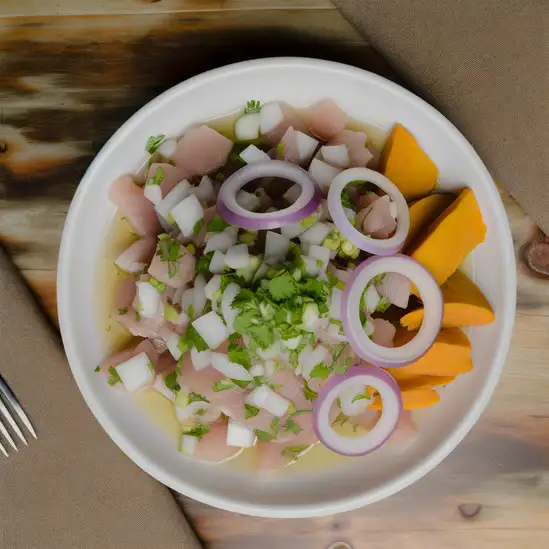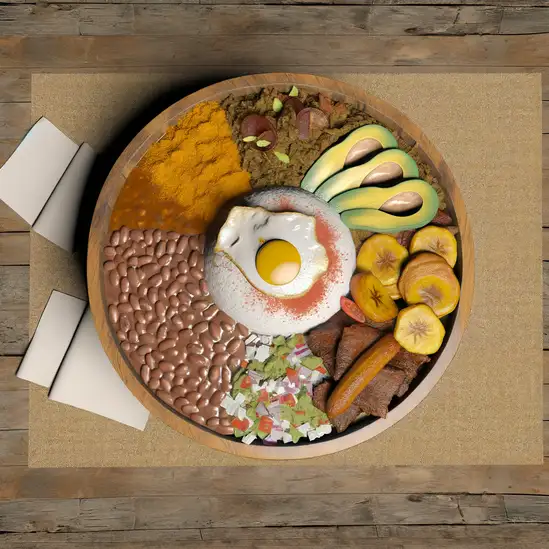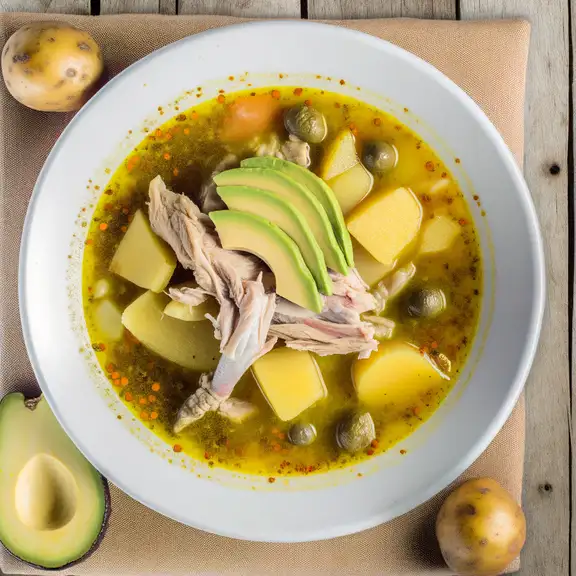



Leticia feels like stepping into a vibrant,living tapestry woven from the heart of the Amazon. The moment you arrive,the air wraps around you—thick with the scent of damp earth,blooming orchids,and the distant hum of jungle life. It’s a place where the river is the main street,and boats drift lazily past colorful markets bursting with fresh tropical fruits and handmade crafts. The chatter of locals,a mix of Spanish and indigenous languages,blends with the calls of exotic birds overhead,creating a soundtrack that’s both lively and soothing. Walking through Leticia,you’ll notice the warmth of its people—friendly smiles that invite you to slow down and savor the moment. The city pulses with a unique energy,a blend of indigenous traditions and Colombian culture that you can taste in every bite of freshly caught river fish grilled with local spices or in the sweet,sticky sap of wild honey sold by market vendors. The streets are alive with vibrant murals and the rhythm of cumbia and Amazonian folk music,making it impossible not to feel connected to the place. What makes Leticia truly unforgettable is its wild,untamed backdrop. Just beyond the city limits,the Amazon rainforest stretches endlessly,promising adventure and discovery. Whether you’re cruising the river at sunset,spotting pink dolphins,or exploring the lush trails,Leticia invites you to experience a world where nature and culture dance together in perfect harmony.
The information on this page is currently being reviewed by Tripkliq and should be used as a guide only
Eng word: Hello
Eng pronunciation: OH-lah
Local language: Hola
Eng word: Goodbye
Eng pronunciation: ah-DYOS
Local language: Adiós
Eng word: Thank you
Eng pronunciation: GRAH-syahs
Local language: Gracias
Eng word: How much
Eng pronunciation: KWAN-toh KWEH-stah
Local language: ¿Cuánto cuesta?
Eng word: Toilet
Eng pronunciation: BAH-nyoh
Local language: Baño
Eng word: Help me
Eng pronunciation: ah-YOO-dah-meh
Local language: Ayúdame
Eng word: Yes
Eng pronunciation: SEE
Local language: Sí
Eng word: No
Eng pronunciation: NO
Local language: No
Eng word: Excuse me
Eng pronunciation: pehr-DOHN
Local language: Perdón
Leticia was officially founded on April 25,1867, and is the southernmost city in Colombia, located on the banks of the Amazon River. It serves as the capital of the Amazonas Department and is a key gateway to the Amazon rainforest.
Leticia is uniquely positioned at the tri-border area where Colombia, Brazil, and Peru meet. This strategic location has made it a hub for cultural exchange and trade among the three nations.
The city played a significant role in the resolution of a territorial dispute between Colombia and Peru. The Leticia Agreement of 1934 peacefully resolved the conflict, solidifying Leticia as part of Colombia.
Leticia is home to a rich mix of indigenous communities, including the Tikuna, Yagua, and Huitoto peoples. Their traditions, crafts, and way of life contribute to the city's vibrant cultural identity.
The Malecón in Leticia is a historical and cultural landmark. It offers stunning views of the Amazon River and serves as a gathering place for locals and tourists to enjoy the city's natural beauty.
Leticia's history and development have been deeply influenced by its proximity to the Amazon River, one of the world's most iconic waterways. The river has been a lifeline for trade, transportation, and exploration.
In 1991, Leticia was designated as the capital of the newly created Amazonas Department, highlighting its importance as a center for governance and development in the region.
This museum in Leticia showcases the history and culture of the indigenous communities in the Amazon region. It is a must-visit for tourists interested in learning about the area's rich heritage.
Over the years, Leticia has become a popular destination for ecotourism. Its history as a gateway to the Amazon rainforest has attracted visitors from around the world seeking to explore its biodiversity and natural wonders.
In Leticia, the most common Power Adaptor is Type A, Type B.



A refreshing dish made from fresh fish or shrimp marinated in citrus juices, mixed with onions, cilantro, and spices, popular in coastal regions and enjoyed in Leticia.

A hearty platter that includes rice, beans, ground meat, chicharrón (fried pork belly), avocado, plantain, and a fried egg, showcasing the rich flavors of Colombian cuisine.

A traditional soup made with meat (often chicken or fish), plantains, yuca, and corn, simmered with spices and served with rice, perfect for a comforting meal.

Cornmeal cakes that can be grilled, baked, or fried, often filled or topped with cheese, meats, or avocado, making them a versatile snack or meal.

A flavorful chicken and potato soup, typically made with three types of potatoes and flavored with guascas, a local herb, served with avocado and capers.

A traditional fish stew made with coconut milk, tomatoes, onions, and peppers, reflecting the Afro-Colombian influence in the region's cuisine.

Twice-fried green plantains that are crispy on the outside and soft on the inside, often served as a side dish or topped with various ingredients.
Manaus feels like stepping into a vibrant heartbeat right in the middle of the Amazon rainforest. The moment you arrive,there’s this electric mix of jungle humidity and the buzz of city life that wraps around you like a warm,humid blanket. You’ll hear the chatter of street vendors,the distant hum of boats on the Rio Negro,and the occasional call of tropical birds weaving through the air. It’s a place where the wildness of nature and the pulse of urban culture collide in the most fascinating way.
Walking through Manaus,you can’t miss the stunning Teatro Amazonas,an opera house that looks like it belongs in Europe but is surrounded by lush greenery and the sounds of the forest. The city’s markets are alive with colors and smells—fresh tropical fruits like cupuaçu and açaí,the scent of spices,and the sizzle of street food grilling right in front of you. Try the local fish dishes; they’re fresh,flavorful,and often cooked with ingredients you won’t find anywhere else.
What really makes Manaus special is its spirit—a blend of indigenous heritage,colonial history,and modern Brazilian energy. People here are warm and proud of their roots,eager to share stories about the river,the forest,and the city’s unique place in the world. If you’re up for an adventure that’s as much about culture and connection as it is about nature,Manaus will surprise you in the best way.
Imagine stepping into a place where the Amazon River hums a steady,soothing rhythm and the air is thick with the scent of damp earth and blooming orchids—that’s Iquitos for you. This city feels like a vibrant crossroads between jungle wilderness and lively urban life,where colorful wooden boats bob along the riverbanks and markets overflow with fresh tropical fruits and spices. The streets buzz with a mix of chatter in Spanish and indigenous languages,and the warm,humid air carries the distant calls of howler monkeys and the occasional splash of a river dolphin.
What’s truly captivating about Iquitos is its unique blend of cultures. You’ll find locals who are deeply connected to the rainforest,sharing stories of medicinal plants and ancient traditions,alongside a growing community of artists and musicians who fill the evenings with soulful tunes and laughter. The city’s architecture is a charming patchwork of colonial-era buildings and rustic wooden houses,all painted in bright,cheerful colors that seem to reflect the energy of the place.
When you wander through the bustling markets,the taste of freshly caught river fish grilled over open flames mingles with the sweetness of exotic fruits like camu camu and aguaje. And if you venture just beyond the city,the jungle opens up in all its wild glory—thick canopies,hidden waterfalls,and the chance to spot creatures you’ve only read about. Iquitos isn’t just a destination; it’s an invitation to slow down,breathe deeply,and dive into a world where nature and culture dance together in perfect harmony.
Cartagena de Indias feels like stepping into a vibrant,sun-soaked painting where every corner bursts with color and life. The moment you wander through its cobblestone streets,you’re wrapped in the warm embrace of colonial charm mixed with Caribbean energy. Brightly painted balconies overflow with bougainvillea,and the salty breeze carries the distant rhythm of cumbia and salsa,inviting you to move with the city’s heartbeat. It’s a place where history isn’t just in museums—it’s alive in the laughter spilling from open-air cafes and the clinking of glasses filled with tangy,refreshing aguardiente.
As you stroll along the ancient city walls,the scent of grilled seafood mingles with tropical fruit from street vendors,tempting your taste buds to dive into fresh ceviche or a juicy mango. The sun sets in a blaze of orange and pink over the bay,and the city lights flicker on,casting a golden glow that makes every evening feel magical. Locals greet you with genuine warmth,eager to share stories about Cartagena’s rich past and vibrant present.
What makes Cartagena truly unforgettable is its blend of old-world romance and lively modern spirit. From the bustling plazas where artists display their work to the quiet corners where you can sip a cold cocktail and watch the world go by,the city invites you to slow down and savor every moment. It’s a place that stays with you long after you leave,whispering promises of return.
An island city in the Caribbean Sea,San Andrés is famous for its crystal-clear waters,white sandy beaches,and vibrant marine life,making it a top destination for snorkeling and diving.
ExploreImagine stepping into a city where the rhythm of samba pulses through the streets and the air carries a salty breeze mixed with the scent of fresh coconut water. That’s Rio de Janeiro for you—a place that feels alive in every sense. From the moment you arrive,you’re wrapped in a vibrant energy that’s both laid-back and electric. The city’s dramatic landscape,with its towering granite peaks like Sugarloaf and the iconic Christ the Redeemer statue watching over the bay,creates a stunning backdrop that’s impossible to forget.
Walking through Rio’s neighborhoods,you’ll hear the laughter of locals chatting in colorful markets,the distant beat of drums from a street party,and the waves gently crashing on golden beaches like Ipanema and Copacabana. The sun warms your skin as you sip on a caipirinha,the tangy lime and sweet sugar blending perfectly with the tropical heat. Food here is a celebration—imagine feijoada bubbling in a pot,or fresh seafood grilled right by the shore,each bite telling a story of the city’s rich culture.
What makes Rio truly special is its spirit—a mix of resilience,joy,and openness. People here embrace life with a contagious passion,whether they’re dancing during Carnival or simply sharing stories over a late-night meal. It’s a city that invites you to slow down,soak in the beauty,and join in the celebration of life. Trust me,once you’ve felt Rio’s heartbeat,it stays with you long after you leave.
A bustling metropolis with a mix of modern skyscrapers and colonial charm,Panama City is the gateway to the San Blas Islands,a stunning archipelago with pristine beaches and indigenous culture.
ExploreSome money changers may offer poor exchange rates or shortchange tourists during currency exchanges.
Unlicensed individuals may pose as tour guides, offering cheap services but providing little value or even leading tourists to unsafe areas.
Vendors may sell mass-produced items claiming they are authentic indigenous crafts, charging inflated prices for low-quality goods.
Some operators may promise wildlife encounters but take tourists to areas where animals are unlikely to be seen, or they may exploit animals in unethical ways.
Tuk-tuk or boat drivers may overcharge tourists, especially if they are unfamiliar with standard rates in the area.
Tour operators may charge tourists significantly higher prices for jungle tours, boat rides, or visits to indigenous communities. Some may not deliver the promised experience.
In crowded areas like markets or near the port, pickpockets may target distracted tourists, especially those carrying valuables in easy-to-access places.
Colombia has strict drug laws, and the possession, sale, or trafficking of drugs is illegal and heavily penalized. While small amounts of certain drugs for personal use have been decriminalized, this does not mean they are legal. Tourists should avoid any involvement with drugs to prevent legal trouble, as enforcement can be strict, especially for foreigners.
In Leticia, Colombia, smoking is regulated under national Colombian laws. Smoking is prohibited in enclosed public spaces, workplaces, and on public transportation. Designated smoking areas may be available in some locations. Tourists should be mindful of these restrictions to avoid fines.
Vaping is subject to similar regulations as smoking in Colombia. It is prohibited in enclosed public spaces, workplaces, and public transportation. While vaping is not as widely regulated as smoking, it is advisable for tourists to follow the same rules to avoid any issues.
What are other people saying about Leticia?
Recent Social posts about Leticia
There is nothing to show you for now.